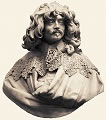|
|
 |
Male
Baroque Clothing
|
 |
During the
reign of Louis XIV, the Sun King, French fashion took over the leading
role in Europe. This was caused by France having developed into
the main political and cultural power, thus turning French fashion
into an equally "absolutistic" regime. During the period from 1660
onwards, fashion in France, according to the absolutistic ideal,
became rigid, ordered and strict in its do's and don'ts of etiquette.
About 10 years after Louis XIV's accession to the throne and maturity
in the year 1661, the entirety of Europe was under the dictatorship
of the French royal fashion in about 1670. From that date on European
rulers strove to imitate the powerful Sun King, they even lost national
differences and diversities in fashion, thus French fashion became
world fashion.
After the Thirty
Years War, when the English King Charles I had been executed and
the Puritans under Cromwell reigned; when Louis XIV was still merely
a child at the signing of the Peace of Westphalia; when the numerous
municipalities of Germany were in ashes and ruins after the horror
of the 30s Years War and possessed neither a political nor a cultural
centre; when the Spanish and Austrian rulers were still clinging
to the old fashioned Spanish court costumes of the 16th century;
there was no court in Europe left who could possibly take over the
leading role in fashion. Thus a different type of model was looked
upon in the 1650s and 60s. The Netherlands, and particularly the
rich, powerful and independent Burghers. There are numerous
paintings of the 1640s-1660s by Dutch artists of every day life
scenes amongst the Dutch upper middle class, which you will find
in the Period Galleries chapter under Dutch
Paintings. The costume of the Dutch was now made of colourful
velvets and silks, decorated with many ribbons.

1650
- 1670
During these
years after the 30s Years War, the fashion for men changed considerably,
from the militaristic uniform style to overboarding gaudiness, which,
in my humble opinion, bordered at the ridiculous. The coat shrank
towards a tiny, open doublet, with sleeves reaching only to the
elbows, and extremely short, ending high above the waist, very similar
to the modern "Bolero" jacket or the Spanish Matador's jacket. The
breeches became that baggy and full, that they looked like wide
skirts. These so-called Rhinegraves are said to have been
a Dutch or German invention: the trouser legs, extremely baggy and
using a large amount of fabric, were gathered below the knees with
lace frills, the so-called Canions. This fashion went to
the extreme that men wore indeed skirts, full skirts over breeches
which led to their name Petticoat breeches. Another characteristic
of this fashion was that the petticoat breeches were worn by the
fashionable gentlemen of the time hanging loosely low at his hips,
so that it almost looked as if he was about to lose his pants.
Yet, the Rhinegraves were extremely popular at the court of the young Louis XIV, and
were worn by the young and old, and they went finally completely
out of fashion only as late as in the 1680s. Between the extremely
short doublet and the low-hanging breeches was the equally full
shirt to be seen. Sometimes this long shirt even became the most
important fashion item of the entire costume.
Furthermore,
the costume was decorated with numerous ribbon bows at doublet,
breeches and shoes, namely most prominently at the waistband of
the breeches, the shoulders, and the bottom hem of the jacket. In
a surviving tailor's list of the 1650s is a note about the amount
of ribbon bows which are needed for a fashionable outfit: about
500-600 ribbon bows, which are called galants in French.
But the uniform
was once more about to influence and change civilian fashion considerably.
When permanent regiments were formed, the time of the freedom of
choice of soldiers' clothing was over. Before, a soldier was usually
serving for and paid by, different armies, but now the necessity
arose to be able to differentiate and identify the regiments in
peace times and also in war time. Therefore the uniforms for the
common soldier became a demand, while the Officers were still able
to choose their clothing freely. This development was enabled by
the building of large cloth manufactories in France with the technicalities
to make and provide large amounts of fabric in uniform colours and
with the same quality throughout. Anyway, the freedom of choice
for Officers was cut down as well after a while and they had to
abide and dress in the uniform of the regiment, including of course
the most high ranking leader of the troops: the King. Thus the uniform
coat became presentable and was adapted by male fashion. The soldiers'
coat transformed into the uniform coat around 1670 by the standardisation
of cut, colours, decorations (buttons, braid, etc.)
One very important
item in the identification of the different regiments was the facings
fabric. The lining, which was always in a different colour as the
outside cloth, was initially only visible at the turned back cuffs;
only much later, when the cut changed and collars were added, were
those made in the colour of the facings as well. The skirts of the
coat, which were turned back by the cavalry and this manner was
imitated by the infantry, showed off the facings colour as well.
There were regulations for every regiment regarding the colours
and shapes of embroidery, braid and cords, with which the higher
ranking coats were decorated and the buttonholes were lined. For
extensive information on Uniforms, visit the Kirke's
Lambs Regiment chapter.

1670-1720
In the course
of the metamorphosis of the soldier's coat into a uniform coat and
later the King's official state coat and thus took its important
place in fashion, did also the cut of this garment change. The coat,
which was rather wide and shapeless in the beginning, became more
and more fitting to the figure at the upper body, tight at the waist,
so that this coat was named Justaucorps, which means "just
at the body", developing into a tight fitting, tailored garment,
into this extremely elegant and flattering piece of clothing.
This liaison
of uniform and fashion led to the influence of rationalism in male
fashion, and also the sleeves, which had played such a prominent
role in 16th century fashion with their padded and extreme vastness,
were turned into simple, tubular sleeves. Those tubular shaped sleeves
came into fashion around 1665, when Louis XIV started to adopt this
shape for his mourning garments after his father in law's death,
Philip IV of Spain. This sleeve shape has been fashionable since
then until modern times. The cuffs of the sleeves in the 17th century
were very broad and wide and turned back, decorated with buttons
and braids. The coats' wide skirts had now pockets, a new and very
practical invention. The slits in the skirts had a practical reason
as well: the slit in the back was necessary to prevent sitting on
one's coat skirts when riding, the side slits to allow the smallsword
through.
Around 1685
was a change in the way of how to carry one's weapon: the sword
hanger, or baldrick, worn hanging across one shoulder, was
replaced by a sword belt around the hips. This change took place
first in the military, and then this fashion was gradually adopted
into civilian clothing as well. But first of all, in the course
of this development, it became fashionable in civilian dress, to
wear the sword belt, or bandelier in French, underneath the
coat. Thus the coat's skirt side seams had to be left open, so that
the rapier or smallsword could slide through.
The open side
seam had at first a small row of buttons, then, when the skirts
became very full around 1700, one button at the waist, where the
seam opened, and an inset of folds, so that the skirt didn't open
and had an even more elegant cut and shape.
The large lace
collar, which was worn during the first half of the 17th century,
became smaller at the back and the sides after the 1650s, because
the hair was worn much longer. In the end only the strips of fabric
remained, which were folded over at the front. These strips, or
front edges of the former large collar, became longer, until the
collar had developed into the cravat. These cravats, which
occurred in the 1670s side by side with the collars, were knotted
in the front and held in place by silk ribbon bows in the 1680s,
together with the silk ribbon bows at the shoulder the last remains
of the former, overflowing ribbon decoration. These last ribbons
were to vanish as well during the last decade of the 17th century.
The so-called Steinkerke or Steenkerk appeared, once
again after having been seen first amongst the military, around
1692, and this cravat fashion's characteristics are the two long
ends of the fine cravat being simply gathered in the front and very
elegantly and casually fastened by slipping the two ends through
one buttonhole.
The waistcoat
was given a new name too: la veste, the vest. It was always
worn underneath the justaucorps, and very different to the vest
which is worn nowadays, the modern waistcoat derives its cut from
the 18th century vest. The vest of the 17th century was at first
made out of the same fabric as the coat and had almost the same
cut, but it was not flared like the cut. Around 1690 it became fashionable
to make the vest from very precious and colourful brocades or brocaded
and patterned silks, and to give the large turned back cuffs of
the justaucorps facings of the vest fabric, while the coat
was then made from a plain fabric. The vest was nearly as long as
the coat, maybe only an inch shorter, tight fitting in the waist
as well, and with long, tubular shaped narrow sleeves, though without
any cuffs. It had pockets too and slits, but without the additional
insets which the coat later had at the side seams.
At the same
time, when the change in the upper body garments occurred, did the
breeches change too. The formerly fashionable petticoat breeches
didn't fit the new, tailored coat at all anymore, and in 1682 an
article was published in the first French fashion journal Mercure
de France stating clearly that "canons and rhinegraves are impossible".
Now the voluminous rhinegraves were finally and forever exchanged
with knee-length breeches of normal width. But since the breeches
almost completely vanished underneath the knee-length Justaucorps
and vest, and were furthermore covered by the stockings, which were
rolled over the breeches up to above the knee, the breeches were
the most unimportant item of clothing of the entire male costume
and thus very plain.
The overcoat
was surely no longer an item of any fashionable importance and was
neglected, especially since the justaucorps was always worn together
with the vest, both being lined, this made the overcoat almost always
unnecessary. The sleeveless cloak was only worn any longer when
travelling, and the only overcoat was the so-called Brandenbourg with sleeves, which was buttoned at the front. This overcoat had
a broad collar, which was also to be buttoned at the front, the
garment wasn't shaped to the figure at all, had a baggy, wide appearance
and was always longer than the tight fitting coat, the justaucorps.

Female
Costumes
Ladies' Baroque Clothing
Indoor
Garments | Footwear | Accessories | Hairstyles | Head-dresses | Development
of the Fontange
Hairstyles
by Vermeer | Dress
Colours by Vermeer | Head-dresses
by Vermeer
Costume Focus Headwear & Neckwear | Costume
Focus Working Women
Costume
Focus Children's Clothing
Ladies'
Costume Quotes
Male
Costumes
Gentlemen's Baroque Clothing
Indoor
Garments | Footwear | Accessories | Hairstyles | Head-dresses
Costume
Colours by Vermeer | Hair-
and Head-dresses by Vermeer
Gentlemen's
Costume Quotes
~ ~ ~ ~ ~ ~ ~ ~ ~ ~ ~ ~ ~
Embroidery Gallery | Gallery of Needlework
Engravings
Lace Gallery &
Identification | Glossary
Contents © N. Kipar 1997 |









